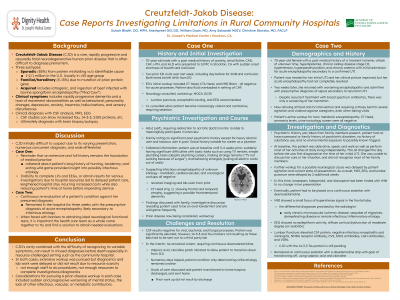Infectious Disease and HIV Psychiatry
(079) Creutzfeldt-Jakob Disease: Case Reports Examining Community Hospital Investigations and Limitations


Suhair A. Bhatti, DO (he/him/his)
Resident Psychiatrist
St. Joseph's Medical Center
Stockton, California- WD
William R. Duan, MD
Psychiatry Resident Physician
St. Joseph's Medical Center in Stockton
Fremont, California - AG
Arashpreet K. Gill, DO
Resident Physician
Saint Joseph’s Medical Center
STOCKTON, California - AS
Amy Sakazaki, BS
Medical Student
Touro University
Sacramento, California
Presenting Author(s)
Co-Author(s)
Creutzfeldt-Jakob disease (CJD) is a rare, rapidly progressive and assuredly fatal neurodegenerative human prion disease that is often difficult to diagnose premortem as the rarity of CJD, combined with the difficulty of recognizing its symptoms, can result in missed diagnoses before death especially in resource-challenged setting such as the community hospital. This case report describes two patients who presented with acute encephalopathy, posing diagnostic challenges due to atypical presentations and lack of response to standard treatments; both of these patients’ prion testing in this community hospital were slowed by lack of access and resources. The cases include: a 70-year-old male with a history of heart failure and confusion who presented with worsening cognitive decline, with initial workup for common etiologies unrevealing, though with family history of past taxidermy work raising suspicion for prion disease, prompting CSF analysis for 14-3-3 and tau proteins; a 70-year-old female with a history of chronic medical conditions who presented with altered mental status and agitation, for whom despite extensive workup for infection, metabolic abnormalities, and autoimmune etiologies, no clear diagnosis was initially established, though a CJD workup was initiated due to rapid cognitive decline and limited alternative explanations. Both cases highlight the importance of considering CJD in patients with rapidly progressive encephalopathy, particularly when common causes are ruled out and the cases occur in resource-challenged areas. The first case emphasizes the value of a comprehensive history, while the second case underscores the need for continuous reevaluation and a broadened differential diagnosis. These cases additionally illustrate the challenges in diagnosing CJD due to its variable presentations and suggest that maintaining a high index of suspicion for CJD and including it in the differential diagnosis for unexplained encephalopathy can expedite appropriate workup and improve patient management.
Presentation Eligibility: not previously published or presented
Diversity, Equity, and Inclusion: All or most of the four authors are of a minority background race, ethnicity, and religions. They also have an equal representation of men and women. There is both psychiatry resident, family medicine resident, and medical student input and contributions showcasing the diversity in thoughts. Lastly, both cases described in the abstract occurred in the extremely heterogenous, diverse, and resource and care-challenged community of Stockton, California.

